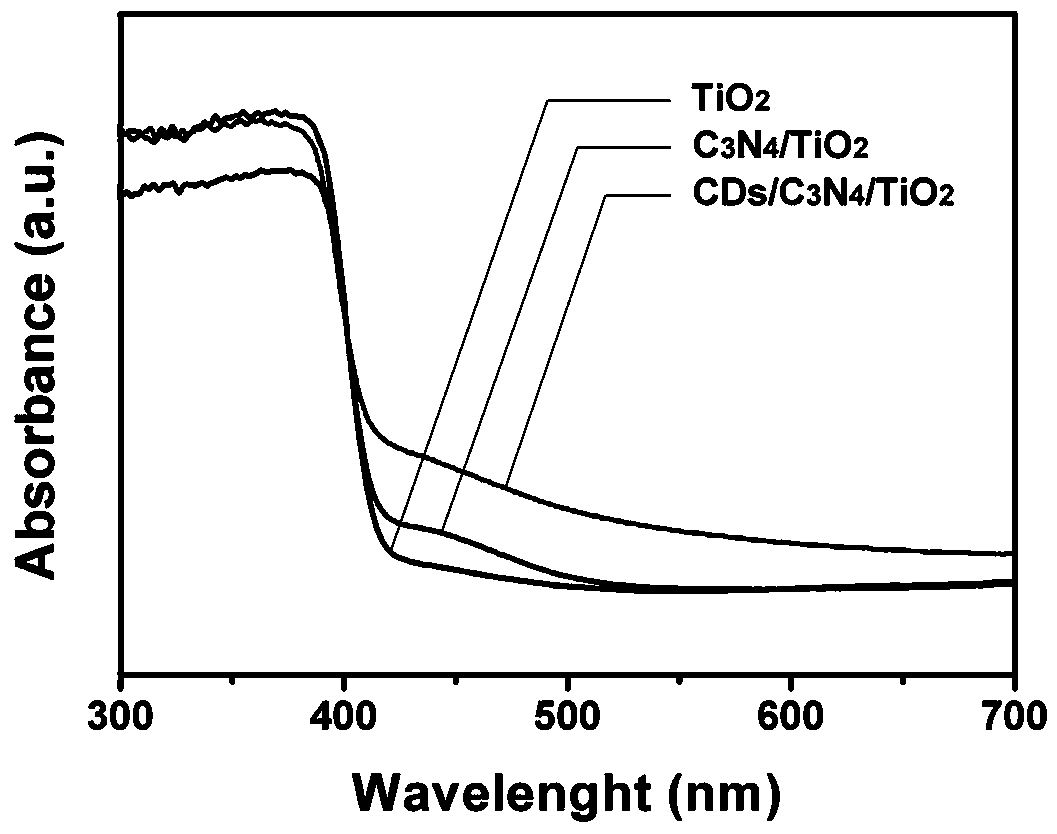Titanium dioxide photoelectrode co-modified by carbon dots and carbon nitride, as well as preparation method and application thereof
A technology of titanium dioxide and photoelectrode, which is applied in the direction of electrodes, electrolytic processes, electrolytic components, etc., can solve the problems of low utilization rate of visible light, application hindrance, and low utilization rate of carriers, so as to improve photocatalytic efficiency and reduce serious charge recombination , the effect of improving conductivity
- Summary
- Abstract
- Description
- Claims
- Application Information
AI Technical Summary
Problems solved by technology
Method used
Image
Examples
Embodiment 1
[0024] A method for preparing a carbon dot and carbon nitride co-modified titanium dioxide photoelectrode, comprising the following steps:
[0025] (1) Preparation of titania photoelectrode
[0026] Add isopropyl titanate to a hydrochloric acid solution with a mass fraction of 18.7% (the volume ratio of hydrochloric acid solution to isopropyl titanate is 3:0.06), stir until the mixed solution becomes clear, and then transfer the mixed solution to a polytetrafluoroethylene In the ethylene-lined reactor, place the cleaned FTO conductive glass with the conductive side down in the reactor, put the reactor in an oven at 150°C for 12 hours, then cool it down to room temperature naturally, and heat the water after the reaction The conductive glass is taken out and washed with deionized water, and the high-purity N 2 Blow it dry, then put it into a muffle furnace and raise the temperature to 550°C at a rate of 5°C / min for 3 h, then cool it down to room temperature naturally to obtain...
Embodiment 2
[0042] A method for preparing a carbon dot and carbon nitride co-modified titanium dioxide photoelectrode, comprising the following steps:
[0043] (1) Preparation of titania photoelectrode
[0044] Add n-butyl titanate to 15% hydrochloric acid solution (the volume ratio of hydrochloric acid solution and n-butyl titanate is 3:0.04), stir until the mixed solution becomes clear, and then transfer the mixed solution to polytetrafluoroethylene In the ethylene-lined reactor, place the cleaned FTO conductive glass with the conductive side down in the reactor, put the reactor in an oven at 130°C for 24 hours, and then cool it down to room temperature naturally. After the hydrothermal reaction The conductive glass is taken out and washed with deionized water, and the high-purity N 2 Blow it dry, then put it into a muffle furnace to raise the temperature to 500°C at a rate of 3°C / min for 3.5 hours, and cool it down to room temperature naturally to obtain a titanium dioxide photoelectr...
Embodiment 3
[0050] A method for preparing a carbon dot and carbon nitride co-modified titanium dioxide photoelectrode, comprising the following steps:
[0051] (1) Preparation of titania photoelectrode
[0052] Add isopropyl titanate to 20% hydrochloric acid solution (the volume ratio of hydrochloric acid solution and isopropyl titanate is 3:0.07), stir until the mixed solution becomes clear, and then transfer the mixed solution to polytetrafluoroethylene In the ethylene-lined reactor, place the cleaned FTO conductive glass with the conductive side down in the reactor, put the reactor in an oven at 170°C for 8 hours, and then cool it down to room temperature naturally. After the hydrothermal reaction The conductive glass is taken out and washed with deionized water, and the high-purity N 2 Blow it dry, then put it into a muffle furnace to raise the temperature to 600°C at a rate of 7°C / min for 2.5 hours, and cool it down to room temperature naturally to obtain a titanium dioxide photoele...
PUM
| Property | Measurement | Unit |
|---|---|---|
| concentration | aaaaa | aaaaa |
| thickness | aaaaa | aaaaa |
| electrical resistance | aaaaa | aaaaa |
Abstract
Description
Claims
Application Information
 Login to View More
Login to View More - R&D
- Intellectual Property
- Life Sciences
- Materials
- Tech Scout
- Unparalleled Data Quality
- Higher Quality Content
- 60% Fewer Hallucinations
Browse by: Latest US Patents, China's latest patents, Technical Efficacy Thesaurus, Application Domain, Technology Topic, Popular Technical Reports.
© 2025 PatSnap. All rights reserved.Legal|Privacy policy|Modern Slavery Act Transparency Statement|Sitemap|About US| Contact US: help@patsnap.com



